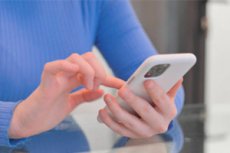New publications
Smartphone sensors detect mental disorders from everyday behavior
Last reviewed: 27.07.2025

All iLive content is medically reviewed or fact checked to ensure as much factual accuracy as possible.
We have strict sourcing guidelines and only link to reputable media sites, academic research institutions and, whenever possible, medically peer reviewed studies. Note that the numbers in parentheses ([1], [2], etc.) are clickable links to these studies.
If you feel that any of our content is inaccurate, out-of-date, or otherwise questionable, please select it and press Ctrl + Enter.

Smartphones can help people stay healthy by tracking sleep, steps and heart rate, but they can also identify mental health issues, a new study has found.
In a study published in JAMA Network Open, researchers from the University of Michigan, the University of Minnesota, and the University of Pittsburgh used smartphone sensors as “silent observers” of everyday life. These digital traces recorded simple actions like how much we move, sleep, or how often we check our phones, but also provided surprising insights into how our psychological well-being manifests itself in our daily habits.
Researchers have found that many different mental health disorders share similar behavioral patterns, such as staying home longer, going to bed late, and charging your phone less often. These behaviors may reflect levels of something called the “p-factor,” which is associated with many mental health problems.
Aidan Wright, a professor of psychology and the Phil F. Jenkins Research Chair in Depression at the University of Michigan's Isenberg Family Depression Center, said the team found that certain behaviors, such as making fewer phone calls or going for walks less often, correspond to specific problems, such as decreased social activity or poor health.
"These results show that major forms of mental illness can be detected using smartphone sensors, indicating that this technology could potentially be used to monitor symptoms and conduct research on a wide range of psychiatric disorders," said Wright, senior author of the study.
The study used data from smartphone sensors from 557 adults over 15 days in 2023, making it one of the largest of its kind. Despite widespread interest in using phone sensors and wearables to diagnose and track mental illness, progress in the field has been modest, Wright said.
“This is partly because most work in digital psychiatry has not taken into account how mental illnesses are structured within the individual when choosing targets for prediction and monitoring,” he explained.
Digital psychiatry has relied heavily on diagnoses from the Diagnostic and Statistical Manual of Mental Disorders (DSM-5), which are weak targets for detection and monitoring because they are heterogeneous. This means the diagnoses lump together different types of symptoms that may have different behavioral manifestations, and often share symptoms with other diagnoses, Wright noted.
To make matters worse, in clinical practice most patients have more than one diagnosis, making it difficult to understand which one is responsible for their behaviour, he added.
"In other words, these diagnoses do a poor job of separating mental illnesses," he said.
Whitney Ringwald, an associate professor of psychology at the University of Minnesota and lead author of the study, said the findings provide insight into why various forms of psychopathology can impair the daily functioning of those who suffer.
Mental illnesses often develop gradually and are best treated in the early stages, before they become serious and disabling. However, Wright says they are difficult to track:
"What we have now is too little and is completely inadequate for the task."
“Being able to use passive sensors to connect a person with help before the situation gets too bad would have huge benefits, including better treatment outcomes, reduced costs and reduced stigma,” he concluded.
